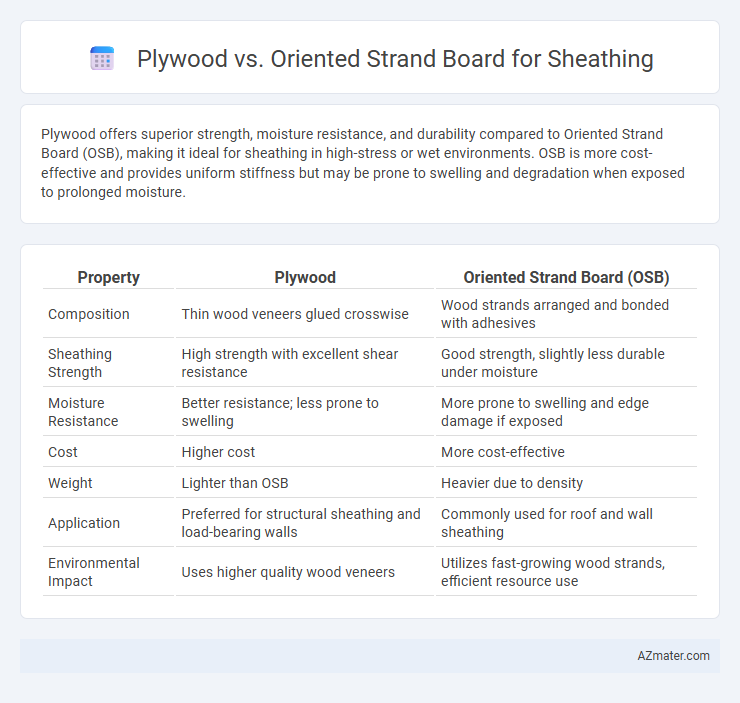Plywood offers superior strength, moisture resistance, and durability compared to Oriented Strand Board (OSB), making it ideal for sheathing in high-stress or wet environments. OSB is more cost-effective and provides uniform stiffness but may be prone to swelling and degradation when exposed to prolonged moisture.
Table of Comparison
| Property | Plywood | Oriented Strand Board (OSB) |
|---|---|---|
| Composition | Thin wood veneers glued crosswise | Wood strands arranged and bonded with adhesives |
| Sheathing Strength | High strength with excellent shear resistance | Good strength, slightly less durable under moisture |
| Moisture Resistance | Better resistance; less prone to swelling | More prone to swelling and edge damage if exposed |
| Cost | Higher cost | More cost-effective |
| Weight | Lighter than OSB | Heavier due to density |
| Application | Preferred for structural sheathing and load-bearing walls | Commonly used for roof and wall sheathing |
| Environmental Impact | Uses higher quality wood veneers | Utilizes fast-growing wood strands, efficient resource use |
Introduction to Plywood and Oriented Strand Board (OSB)
Plywood consists of thin wood veneers glued together with alternating grain directions, providing exceptional strength and resistance to warping, making it ideal for sheathing applications. Oriented Strand Board (OSB) is engineered from compressed wood strands arranged in specific orientations and bonded with adhesives, offering a cost-effective and moisture-resistant alternative to plywood. Both materials are widely used in construction sheathing, with performance characteristics tailored to structural stability and environmental exposure.
Understanding Sheathing: Purpose and Importance
Sheathing serves as a critical structural layer in building construction, providing rigidity, strength, and a base for siding and roofing materials. Plywood offers superior moisture resistance and durability due to its cross-laminated veneers, making it ideal for long-term structural integrity. Oriented strand board (OSB) provides an economical alternative with good shear strength but can be more susceptible to moisture damage if not properly sealed.
Composition and Manufacturing Process of Plywood
Plywood consists of multiple thin layers of wood veneers glued together with alternating grain directions, enhancing strength and stability for sheathing applications. Manufactured through heat and pressure, these veneers are bonded with waterproof adhesives, resulting in a durable and moisture-resistant panel. This layered construction contrasts with oriented strand board (OSB), which uses compressed wood strands aligned in specific directions for uniform strength.
Composition and Manufacturing Process of OSB
Oriented strand board (OSB) is made from thin, rectangular wood strands arranged in layers with their grains oriented perpendicularly, bonded using waterproof adhesives, offering greater uniformity and strength than plywood, which consists of thin wood veneers glued in alternating grain directions. The manufacturing process of OSB involves compressing these strands under heat and pressure, creating a dense, structural panel ideal for sheathing. OSB's engineered layering and resin bonding result in superior moisture resistance and dimensional stability compared to traditional plywood sheathing.
Strength and Structural Performance Comparison
Plywood offers superior strength and structural performance compared to oriented strand board (OSB) for sheathing due to its cross-laminated veneer construction, which provides enhanced shear resistance and load-bearing capacity. OSB, made from compressed wood strands with adhesive, delivers consistent strength but typically falls short in moisture resistance and long-term durability under stress. Structural tests demonstrate plywood's higher stiffness and better nailed withdrawal strength, making it the preferred choice for applications requiring robust wall, roof, and floor sheathing.
Moisture Resistance and Durability Differences
Plywood offers superior moisture resistance compared to oriented strand board (OSB) due to its cross-laminated veneer construction, which limits water absorption and reduces the risk of warping or delamination. OSB tends to swell and degrade faster when exposed to prolonged moisture, although newer water-resistant OSB treatments have improved durability under damp conditions. For sheathing applications in high-humidity or exterior environments, plywood's enhanced dimensional stability and resistance to fungal decay make it a more durable choice than OSB.
Cost Analysis: Plywood vs. OSB for Sheathing
Plywood sheathing typically costs 10-15% more than oriented strand board (OSB), but offers superior moisture resistance and durability. OSB provides a budget-friendly alternative, priced around $15 to $25 per sheet compared to plywood's $20 to $30 per sheet, making it attractive for large-scale projects with tight budgets. Long-term cost considerations favor plywood due to reduced maintenance and replacement expenses stemming from its enhanced structural performance.
Installation Process and Workability
Plywood offers easier handling and cutting due to its uniform layers and smooth surface, making the installation process faster and more precise for sheathing applications. Oriented Strand Board (OSB) requires slightly more effort during cutting because of its rougher texture and denser composition, but it provides consistent panel strength and is often preferred for its cost-effectiveness. Both materials can be installed using similar fasteners and techniques, but plywood's superior workability reduces the risk of splintering and improves overall installation efficiency.
Environmental Impact and Sustainability Factors
Plywood sheathing typically has a lower environmental impact due to its use of thin wood veneers sourced from responsibly managed forests, which enhances its sustainability credentials by promoting renewable forestry practices. Oriented strand board (OSB) is often considered more sustainable because it utilizes smaller, fast-growing trees and wood strands, reducing waste and contributing to efficient wood utilization. Both materials offer eco-friendly benefits, but OSB's manufacturing process tends to have a slightly higher carbon footprint due to adhesives and energy use.
Best Applications and Recommendations for Sheathing
Plywood offers superior strength, moisture resistance, and dimensional stability, making it ideal for exterior sheathing on roofs and walls in high-humidity or load-bearing applications. Oriented Strand Board (OSB) provides cost-effective sheathing with good structural performance, best suited for interior wall panels and non-exposed roof decking in dry environments. For optimal durability and weather resistance, plywood is recommended for areas prone to moisture, while OSB is preferred for budget-conscious projects with controlled conditions.

Infographic: Plywood vs Oriented strand board for Sheathing
 azmater.com
azmater.com